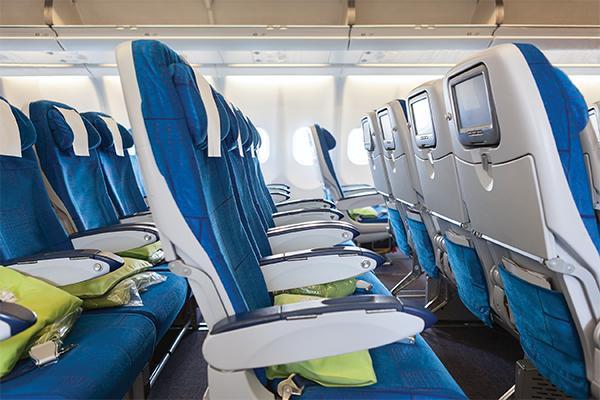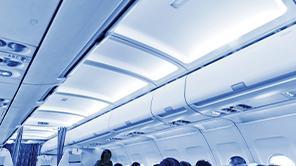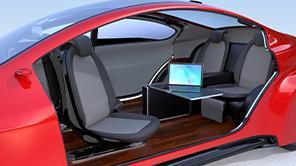Enhancing Aerospace Interior Design with Ergonomic Positioning Technology

Adding torque hinging solutions into interior aircraft applications helps to control motion and absorb vibration, creating a quality experience for end users that interact with these touch points.
For aircraft seating designers, reducing weight while preserving a quality experience for the passenger is often a delicate balance. While many original equipment manufacturers (OEMs) are concentrating efforts on stripping weight out of everything from the aircraft body to passenger seating, using lightweight materials in certain applications comes with its own share of risk. Adding lightweight materials to interior touch points with for instance, can negatively influence an individual’s overall perception of quality towards the aircraft carrier.
In order to ensure that quality and end user comfort is not sacrificed when replacing traditional materials with lightweight options, design engineers are adding torque hinges to interior cabin applications. These lightweight positioning solutions provide ergonomic functionality for passengers as well as crew members and maintenance personnel.
Benefits of Constant Torque
Hinges and display mounts designed with pre-engineered constant torque technology provide a full range of motion that improves passenger ergonomics and usability, and offers the following design benefits:
- Supports a display screen or table when it must remain stationary, yet allows it to be easily adjusted with one hand
- Able to withstand vibration and inertial loading that may result while the airship is in operation
- Can be moved in multiple directions and angles, allowing displays to be easily pulled toward or pushed away from passenger as needed
- One-handed operation allows simple one-touch positioning of displays, doors and panels
- Reliable, repeatable cycle life that eliminates the need for service or adjustment during operation
Food Trays
Constant torque hinges use engineered friction systems to provide continuous resistance against motion, making a lightweight plastic table or tray feel heavier and more substantial, thus improving the passenger experience. Since constant torque hinges provide resistance throughout the entire range of motion, it allows the user to easily adjust a tray, keeping it in any position the user desires.
This type of positioning technology also provides the advantage in that the design can be dialed in to withstand the forces designated by the OEM for the best ergonomic feel. Adding torque hinging solutions into seating applications, like Southco’s CT Hinge series not only helps to control motion, it also can improve or prevent buzz, squeak and rattle, resulting in a quality experience for the passenger.
Headrests
Another area where torque hinges can be used to provide a quality end user experience is in headrest design. With current designs, vertical adjustment has previously been achieved with limited success, resulting in inconsistent cycle life. Outdated vertical friction affects the reliability and functionality of headrests over time, resulting in a design that cannot maintain position and thus no longer supports a passenger’s head.
Southco’s headrest solutions feature standard integrated positioning technology, which provide reliable and flexible constant torque capabilities in a small package, allowing them to be seamlessly integrated into OEM seating designs. Asymmetric torque allows the design engineer to specify various operating efforts in different directions of motion, allowing end users to easily pull the wings forward for adjustment, yet still be supported when resting their full weight against it.
This lightweight headrest solution can be integrated into reduced weight seat designs and mounts to the back of a seat body or existing structure. Rather than bolting on additional hardware, Southco can also incorporate both vertical slide and wing tilt elements directly into the headrest solution. These integrated solutions result in additional weight savings that can be achieved over traditional headrest designs.
Interior Panels and Doors
Incorporating constant torque hinges into overhead access panels and interior doors allows aircraft maintenance and crew to move these panels into position and have them stay in place. This enhanced functionality keeps a door or panel from falling down, allowing personnel to safely keep both hands free and work more efficiently.
Hinges designed with asymmetric torque for example, counteract the impact of gravity by allowing the end user to move the panel or door freely in either direction, and feel no perceived difference in force. Southco hinges provide a full range of motion, allowing aircraft personnel to adjust the panel as needed, without the need for an additional mechanism, such as a prop rod or tether to keep it open. This reduces the risk of potential on the job injuries that could be caused by falling doors or panels in a variety of interior applications, from lavatory cabinets to overhead maintenance panels.
IFE Systems
Aerospace OEMs are designing cutting-edge inflight entertainment (IFE) mounts into arm rests or in seat backs, which can be easily folded out and stowed when not in use. In these applications, constant torque hinges simplify the adjustment and positioning of a passenger’s tablet or smartphone, and prevents drift caused by fingertip use or vibration during flight.
Southco’s Display Mounts can be easily positioned to accommodate different passenger heights and seat positions without the need for readjustment.
With the Federal Aviation Administration (FAA) recently lifting its ban on the use of smaller electronic devices during takeoff and landing, and the rise of gate-to-gate connectivity allowing passengers to connect to inflight networks once they board the aircraft, carriers are exploring new ways to make tablet use more ergonomic. ST series hinges provide consistent torque over high cycle life requirements and can be easily integrated into seating designs to provide consistent operating effort in the smallest, lightweight package requirements.
Conclusion
With lightweighting at the forefront of new aircraft designs, engineers are tasked with integrating lightweight materials into interior applications that provide enhanced functionality and fuel efficiency. Choosing lightweight, quality mechanisms are key to ensuring a positive experience for passengers, crew and maintenance personnel. Incorporating positioning solutions designed with lighter materials enhances ergonomics in aircraft interior applications, providing a comfortable, quality experience that end users desire.



